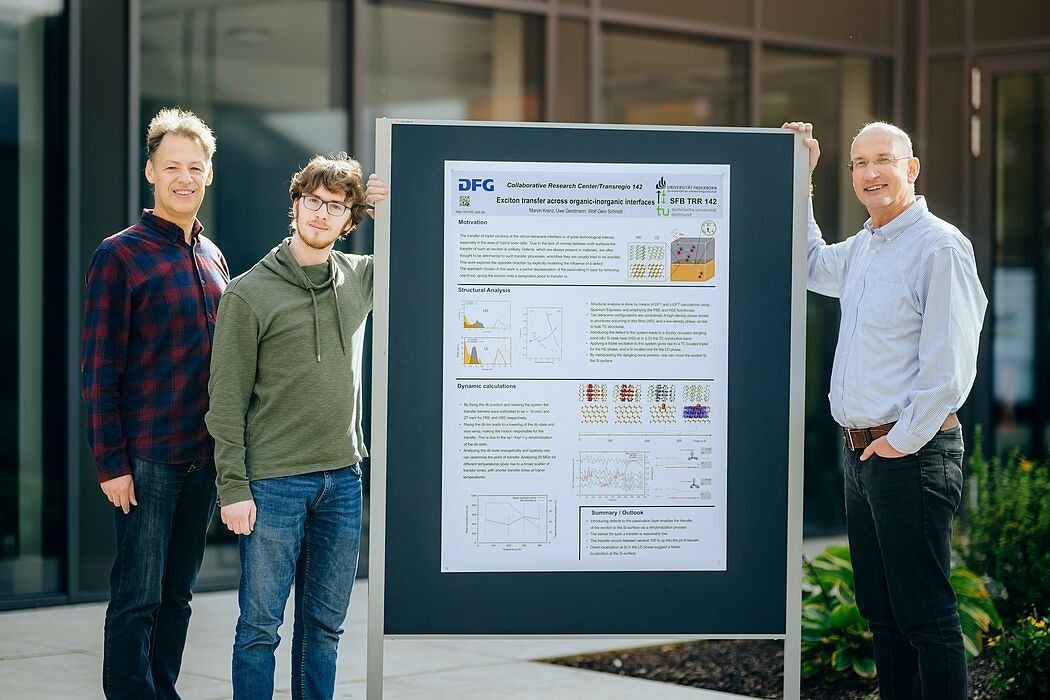Researchers at Paderborn University have created a novel design for solar cells that are substantially more efficient than those that were previously on the market by using intricate computer simulations. The efficiency gain is attributable to a thin covering of organic material called tetracene. Physical Review Letters published the findings.
 (From left to right) The authors Prof Dr Uwe Gerstmann, Dr Marvin Krenz and Prof Dr Wolf Gero Schmidt with their poster on energy transport in the solar cell. Image Credit: Paderborn University, Besim Mazhiqi
(From left to right) The authors Prof Dr Uwe Gerstmann, Dr Marvin Krenz and Prof Dr Wolf Gero Schmidt with their poster on energy transport in the solar cell. Image Credit: Paderborn University, Besim Mazhiqi
The annual energy of solar radiation on Earth amounts to over one trillion kilowatt hours and thus exceeds the global energy demand by more than 5000 times. Photovoltaics, i.e. the generation of electricity from sunlight, therefore offers a large and still largely untapped potential for the supply of clean and renewable energy. Silicon solar cells used for this purpose currently dominate the market, but have efficiency limits.
Dr. Wolf Gero Schmidt, Physicist and Dean, Faculty of Natural Sciences, Paderborn University
This is due, in part, to the fact that some of the energy from short-wave radiation gets transformed into undesired heat rather than electricity.
Schmidt added, “In order to increase the efficiency, the silicon solar cell can be provided with an organic layer, for example made from the semiconductor tetracene. Short-wave light is absorbed in this layer and converted into high-energy electronic excitations, so-called excitons. These excitons decay in the tetracene into two low-energy excitations. If these excitations can be successfully transferred to the silicon solar cell, they can be efficiently converted into electricity and increase the overall yield of usable energy.”
Decisive Breakthrough for Rapid Energy Transfer
Schmidt’s group is utilizing sophisticated computer simulations at the university’s high-performance computing center, the Paderborn Center for Parallel Computing (PC2), to study the excitation transfer of tetracene into silicon.
Now, a significant advance has been made: in collaboration with Prof. Dr. Uwe Gerstmann and Dr. Marvin Krenz of Paderborn University, the researchers have demonstrated that unique flaws in the form of unsaturated chemical bonds at the interface between the solar cell and the tetracene film significantly speed up the exciton transfer.
“Such defects occur during the desorption of hydrogen and cause electronic interface states with fluctuating energy. These fluctuations transport the electronic excitations from the tetracene into the silicon like a lift,” Schmidt further added.
Energy losses actually correspond to these “defects” in solar cells. This adds even more weight to the three physicists’ astounding findings.
Schmidt stated, “In the case of the silicon tetracene interface, the defects are essential for the rapid energy transfer. The results of our computer simulations are truly surprising. They also provide precise indications for the design of a new type of solar cell with significantly increased efficiency.”
Journal Reference:
Krenz, M., et. al. (2024) Defect-Assisted Exciton Transfer across the Tetracene-Si(111):H Interface. Physical Review Letters. doi:10.1103/PhysRevLett.132.076201